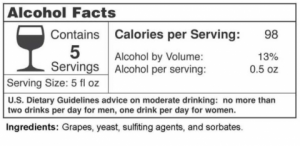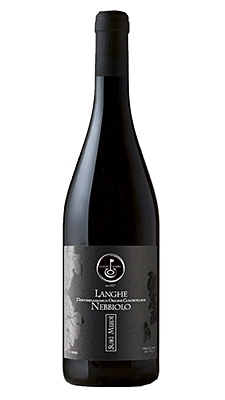For at least a dozen years, an army of health and consumer advocacy groups in the U.S. and Europe has repeatedly called on government to require that wine bottles carry health and nutrition information.
Explore Wine-Searcher
You’ll often see us offering links to Wine-Searcher.com, for a very simple reason: Wine-Searcher.com is the place to go online if you want to find where to buy a particular wine that interests you. But as Wine-Searcher.com has evolved over the years, it has turned into so much more. It’s well worth a visit just to discover its many features, including its popular list of the world’s current ten best value wines!
Through all that time, the wine industry – with few exceptions – has resisted all such efforts, declaring that such labeling would do no one any good and would be terrible for business.
Now the issue is on the table again, as a consortium of U.S. pressure groups including the Center for Science in the Public Interest, the Consumer Federation of America, and the National Consumers League, have called on the federal Alcohol and Tobacco Tax and Trade Bureau (TTB) to write a new proposal for wine labeling. “Consumers of alcoholic beverages deserve the clear, consistent labeling that has long been available to other beverages,” the organizations wrote.
“So, one side thinks nutrition and labels are a good thing for wine, while the wine industry is generally much cooler to the idea,” Becca Yeamans-Irwin wrote yesterday in her excellent blog, The Academic Wino. “What would happen if ingredient and nutrition labels became mandatory for wine? Would people start buying less of it? More? Would anyone actually care?”
Would anyone actually care about wine ingredient labeling? This may be the most important question in the long-simmering issue. Wineries largely oppose labeling requirements for fear that consumers will be put off by discovering trace elements in wine that might range from eggshells or fish bladders (historically used to clarify wine) to modern ingredients like Mega Purple, a commercial ingredient used to impart a deeper, darker color. Not to mention oak chips or the much-feared sulfites.

Pressure groups including the Center for Science in the Public Interest would like to see a wine label that looks like this.
“Studies have shown that consumers, in general, are interested in knowing what’s in a given food product as well as its nutritional content,” Yaemans-Irwin wrote. But, “some research indicates that what consumers say about how they feel regarding these kinds of labels does not predict their actual purchasing behavior. So, the consumer might say nutrition and ingredient labels negatively influence their opinions on a given product, but when it comes to their actual purchasing behavior at the grocery store, they aren’t purchasing that particular product any less than they did before nutrition and ingredient labels on food became mandatory.”
In fact, one Australian study discovered that posting calorie information on wine labels had unintended consequences: Some consumers were angry about being informed, while others chose to reduce the amount of food they ate so that they could still drink the same amount of alcohol, “which would possibly result in increased intoxication and the opposite effect of labeling that some groups are probably hoping for.”
In general, she added, “consumers are interested in seeing nutrition and ingredient information on alcoholic beverages. However, even though consumers say they would like this information, studies have shown that they don’t actually understand what they are reading when they are presented with these details.”
The blog post is long, detailed, and fascinating, with information about many studies on labeling and consumer attitudes and behavior. I commend it to your attention on The Academic Wino site. Click here to read it all.
Or, cutting to the chase, “In summary, despite the negative statements made by participants when directly asked about nutritional/ingredient information on the back label of a wine bottle, the indirect/observational part of the experiment showed that this information doesn’t really matter and that this information wouldn’t change a consumer’s purchase behavior.”
Does this mean that the wineries win? Not necessarily. But if there’s substantial evidence that nutrition and ingredient labels on wine don’t serve their intended purpose, then it’s worth asking whether substantial investment in this effort is justified.
What do you think? Let’s hear your thoughts on wine ingredient labels on our online WineLovers Discussion Group and on our WineLovers Facebook Page.
Today’s Tasting Report
We’re looking into Nebbiolo in this month’s Wine Focus in the WineLovers Discussion Group. Barolo and Barbaresco are the fancy options for this excellent Northwestern Italian variety, and more power to you if you’ve got a cellar full. It’s also possible to find value in varietally labeled Nebbiolo, mostly from Italy but also here and there around the wine world. Let’s pull corks and start tasting this Italian icon! Here’s my first report, a relatively affordable varietal Nebbiolo from the Langhe region of Italy’s Piemonte. You’re invited to come and post your Nebbiolo reports.
Cozzo Mario 2015 “Surì Mesdì” Langhe Nebbiolo ($19.99)
This 100 percent Nebbiolo from the Langhe is a medium garnet color shading to a clear edge. Its attractive scent of plums adds an earthy hint of red clay and a faint back note of wildflowers. Good, mouth-filling red fruit is framed by fresh acidity and soft tannins. Tart plums, earth, and bright acidity last in a very long finish. 13.5% alcohol. U.S. importer: Martin & Co. Wines Inc., Crescent Springs, Ky.; Tradizione Imports, NYC., and other regional importers. (March 2, 2019)
FOOD MATCH: .
The winery suggests braised meats, game, and cheeses, and those should all make fine companions. The Impossible Burger 2.0 filled in remarkably well in place of beef.
WHEN TO DRINK: It’s ready to enjoy, especially with appropriate food, but it should last, and possibly improve, for three to five more years.
VALUE:
This classy red is fairly priced in the lower to middle $20 range.
WEB LINK
Here’s a short info sheet on this wine from Tradizione Imports.
FIND THIS WINE ONLINE:
Wine-Searcher.com lists a limited roster of vendors for Cozzo Mario “Surì Mesdì” Langhe Nebbiolo on Wine-Searcher.com.
Tradizione Imports also lists several New York City shops on this information page.
More affordable wines
Want tips to still more good, inexpensive wines? Here are Wine-Searcher links to vendors and prices for a bunch more wines for $10 or less that I’ve told you about during the past year or two. Please tell us about your favorites!
Wine Forum and Social Media
If you have questions, comments or ideas to share about today’s article or wine in general, you’re always welcome to drop by our online WineLovers Discussion Group, the Internet’s first and most civil online community.
Discussions are open for public viewing, but you must register to post. If you’re a Facebook user, you can join our forum with a single click! All you need to do is visit the forum and click “Social Login” at upper right.
We’d also be delighted to have you visit and “Like” our WineLovers Facebook Page. This way you can get Facebook notifications when there’s a new The 30 Second Wine Advisor issue or a topic of particular interest on the WineLovers Discussion Group (WLDG).
Subscriptions and Administrivia
Unsubscribe:
We’re sorry if you must leave us, but simply click the “unsubscribe” link at the bottom of your Email edition to be instantly removed from the mailing list.
Change address:
The quickest and easiest way to change your email address is simply to unsubscribe from your old address and register again from the new one: Subscribe to The 30 Second Wine Advisor (free).
Archives:
Read nearly 20 years of past articles in the Wine Advisor Archives.
Sponsorship Opportunities:
For information, email Robin Garr at wine@wineloverspage.com





